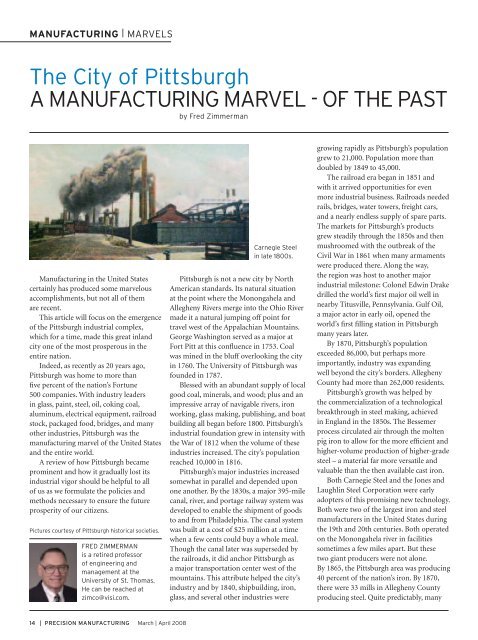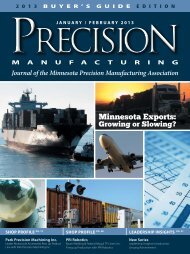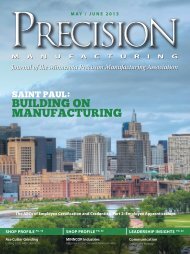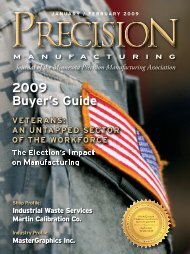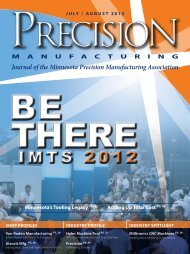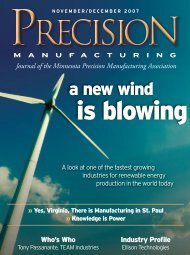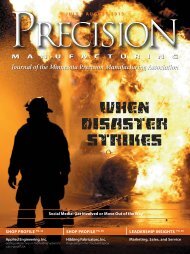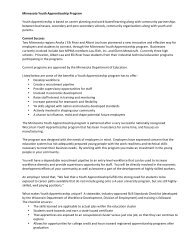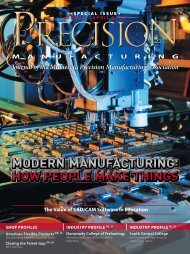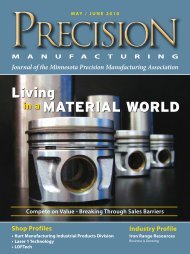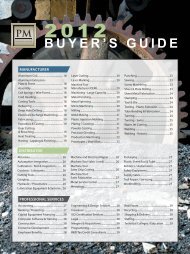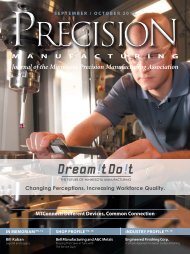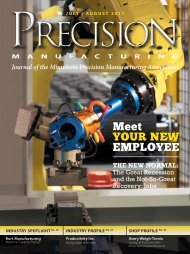U.S. Fabricating: Maintaining Our Edge - Minnesota Precision ...
U.S. Fabricating: Maintaining Our Edge - Minnesota Precision ...
U.S. Fabricating: Maintaining Our Edge - Minnesota Precision ...
Create successful ePaper yourself
Turn your PDF publications into a flip-book with our unique Google optimized e-Paper software.
Manufacturing in the United States<br />
certainly has produced some marvelous<br />
accomplishments, but not all of them<br />
are recent.<br />
This article will focus on the emergence<br />
of the Pittsburgh industrial complex,<br />
which for a time, made this great inland<br />
city one of the most prosperous in the<br />
entire nation.<br />
Indeed, as recently as 20 years ago,<br />
Pittsburgh was home to more than<br />
five percent of the nation’s Fortune<br />
500 companies. With industry leaders<br />
in glass, paint, steel, oil, coking coal,<br />
aluminum, electrical equipment, railroad<br />
stock, packaged food, bridges, and many<br />
other industries, Pittsburgh was the<br />
manufacturing marvel of the United States<br />
and the entire world.<br />
A review of how Pittsburgh became<br />
prominent and how it gradually lost its<br />
industrial vigor should be helpful to all<br />
of us as we formulate the policies and<br />
methods necessary to ensure the future<br />
prosperity of our citizens.<br />
<br />
<br />
<br />
<br />
<br />
<br />
<br />
<br />
<br />
<br />
Pittsburgh is not a new city by North<br />
American standards. Its natural situation<br />
at the point where the Monongahela and<br />
Allegheny Rivers merge into the Ohio River<br />
made it a natural jumping off point for<br />
travel west of the Appalachian Mountains.<br />
George Washington served as a major at<br />
Fort Pitt at this confluence in 1753. Coal<br />
was mined in the bluff overlooking the city<br />
in 1760. The University of Pittsburgh was<br />
founded in 1787.<br />
Blessed with an abundant supply of local<br />
good coal, minerals, and wood; plus and an<br />
impressive array of navigable rivers, iron<br />
working, glass making, publishing, and boat<br />
building all began before 1800. Pittsburgh’s<br />
industrial foundation grew in intensity with<br />
the War of 1812 when the volume of these<br />
industries increased. The city’s population<br />
reached 10,000 in 1816.<br />
Pittsburgh’s major industries increased<br />
somewhat in parallel and depended upon<br />
one another. By the 1830s, a major 395-mile<br />
canal, river, and portage railway system was<br />
developed to enable the shipment of goods<br />
to and from Philadelphia. The canal system<br />
was built at a cost of $25 million at a time<br />
when a few cents could buy a whole meal.<br />
Though the canal later was superseded by<br />
the railroads, it did anchor Pittsburgh as<br />
a major transportation center west of the<br />
mountains. This attribute helped the city’s<br />
industry and by 1840, shipbuilding, iron,<br />
glass, and several other industries were<br />
growing rapidly as Pittsburgh’s population<br />
grew to 21,000. Population more than<br />
doubled by 1849 to 45,000.<br />
The railroad era began in 1851 and<br />
with it arrived opportunities for even<br />
more industrial business. Railroads needed<br />
rails, bridges, water towers, freight cars,<br />
and a nearly endless supply of spare parts.<br />
The markets for Pittsburgh’s products<br />
grew steadily through the 1850s and then<br />
mushroomed with the outbreak of the<br />
Civil War in 1861 when many armaments<br />
were produced there. Along the way,<br />
the region was host to another major<br />
industrial milestone: Colonel Edwin Drake<br />
drilled the world’s first major oil well in<br />
nearby Titusville, Pennsylvania. Gulf Oil,<br />
a major actor in early oil, opened the<br />
world’s first filling station in Pittsburgh<br />
many years later.<br />
By 1870, Pittsburgh’s population<br />
exceeded 86,000, but perhaps more<br />
importantly, industry was expanding<br />
well beyond the city’s borders. Allegheny<br />
County had more than 262,000 residents.<br />
Pittsburgh’s growth was helped by<br />
the commercialization of a technological<br />
breakthrough in steel making, achieved<br />
in England in the 1850s. The Bessemer<br />
process circulated air through the molten<br />
pig iron to allow for the more efficient and<br />
higher-volume production of higher-grade<br />
steel – a material far more versatile and<br />
valuable than the then available cast iron.<br />
Both Carnegie Steel and the Jones and<br />
Laughlin Steel Corporation were early<br />
adopters of this promising new technology.<br />
Both were two of the largest iron and steel<br />
manufacturers in the United States during<br />
the 19th and 20th centuries. Both operated<br />
on the Monongahela river in facilities<br />
sometimes a few miles apart. But these<br />
two giant producers were not alone.<br />
By 1865, the Pittsburgh area was producing<br />
40 percent of the nation’s iron. By 1870,<br />
there were 33 mills in Allegheny County<br />
producing steel. Quite predictably, many


